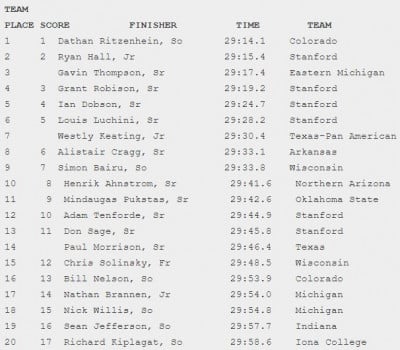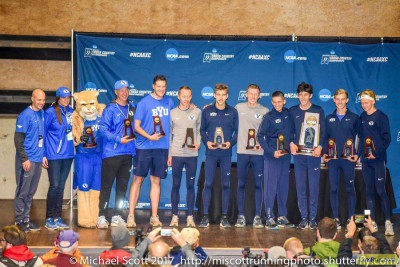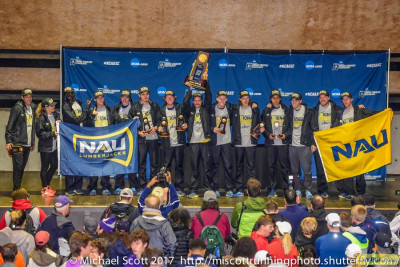2018 NCAA Men’s XC Preview: #2 BYU & #1 Northern Arizona
By LetsRun.com
September 21, 2018
Cross country is back, and the 2018 season promises to be a historic one.
In the team competition, a pair of teams are chasing dynasty status: the Northern Arizona men will be trying to become the first team to win three straight titles since Arkansas from 1998-2000, while the New Mexico women will be gunning for their third title in four years.
Individually, the big story on the men’s side is whether the American drought can end: no U.S. man has won the NCAA individual title since Oregon’s Galen Rupp did it 10 years ago. Northern Arizona’s Tyler Day and Stanford’s Grant Fisher — both top-five finishers a year ago — will look to end that streak. Wisconsin’s Morgan McDonald will be looking to end a drought of his own: no man has won the NCAA title on his home course since Indiana’s Bob Kennedy in 1992, but the Aussie will have a chance this fall as the NCAA championships will be staged at the Zimmer Course for the first time.
That course is another reason to be excited for the season. From 2004-2017, only two cities (Terre Haute and Louisville) hosted NCAAs. But over the next four years, four cities will host, beginning with Madison on November 17 (Terre Haute, Stillwater, Okla., and Tallahassee will follow in 2019, 2020, and 2021). Start planning those itineraries.
For the fifth year in a row, we’re counting down the top 10 men’s and women’s teams in America. These aren’t meant as definitive predictions — there are too many variables to accurately forecast the results of a race two months from now — but consider this a starting point for the national title conversation.
Key dates
September 7: Meets begin to count for NCAA at-large qualifying purposes
September 28: Nuttycombe Wisconsin Invitational, Madison, Wisconsin
October 13: Pre-National Invitational, Madison, Wisconsin
October 26-28: Conference weekend (various sites)
November 9: NCAA regional meets (various sites)
November 17: NCAA championships, Madison, Wisconsin
Previous men’s previews: #10 Syracuse & #9 Boise State * #8 Wisconsin & #7 Colorado * #6 Alabama & #5 Iowa State * #4 Stanford & #3 Portland
Women’s previews: #10 Arkansas & #9 Villanova * #8 Wisconsin & #7 Michigan * #6 NC State & #5 Stanford * #4 Boise State & #3 Colorado * #2 Oregon & #1 New Mexico
Note: We determined where a runner ranked among returners by taking his place in the team scoring at NCAAs in 2017 and subtracting the number of seniors/non-returners in front of him.
New additions in italics
2. BYU: “This would be a good time to win the title, let’s put it that way”
2017 results: 3rd NCAAs, 2nd Mountain Regional, 1st WCC, 1st Pre-Nats
Key returners (lose #1, #6 from NCAAs last year)
| Name | Class | # returner from NCAAs | Credentials |
| Connor McMillan | SR | 15 | 13:38/28:09; 12th NCAA 10k |
| Rory Linkletter | SR | 22 | 7:54/13:37/28:43; 8th NCAA 5k |
| Daniel Carney | SR | 25 | 7:57/13:39/8:41 steeple |
| Kramer Morton | SO | 36 | 3:46/14:28 |
| Clayton Young | SR | 55 | 7:49/13:37/28:27 |
| Conner Mantz | RS FR | N/A | 13:52/28:57 |
| Clayson Shumway | SO | N/A | 13:54/8:36 steeple; 7th NCAA steeple |
| Jacob Heslington | JR | N/A | 14:01/8:39 steeple |
| Dallin Farnsworth | SR | N/A | 13:53/29:17 |
BYU entered last year’s NCAA meet expecting to go toe-to-toe with Northern Arizona. But NAU’s aggressive strategy, keyed by its top two runners, Matt Baxter and Tyler Day, was too much for the Cougars to handle, and the Lumberjacks ran away with the national title. BYU finished third — still the program’s best finish since 1993.
“We really had our worst day of the year,” says BYU coach Ed Eyestone. “As we looked at it, we realized that had we run up to par, we would have been second. I think NAU would have been really tough to beat, we would have really had to pull the rabbit out of the hat to beat them that day. So I think that took some of the hurt off the fact that it was an off day for us.
“I don’t know that we would have done anything that much differently. I have one or two runners who traditionally have faded towards the end of the season so we’ve done some things differently with them in the summer…we’ve kind of delayed a little bit the progression that we go through in the summertime in terms of tempo runs and long intervals and things like that. Starting some of those things three to four weeks [later than usual], a little bit later, I think will put us on where we want to be late in the season.
“But you know what? When you have an issue like that, I mean, we ended up third at the national meet. So you don’t end up throwing the baby out with the bathwater when it’s been a storied year for you. You just try to fine-tune things.”
BYU’s top finisher at NCAAs last year, true freshman Casey Clinger, is on a two-year mission to Sapporo, Japan, and will not factor for the Cougars this season. Eyestone said that he did not try to convince him to delay the mission for another shot at the title in 2018.
“That’s really a personal thing, it’s between them and their family and their bishop,” says Eyestone, who served a mission in Barcelona after his freshman year as an undergrad at BYU. “And quite frankly, we were happy to have him for the cross country season that we had him in. And we also acknowledge that we’ve got guys in the pipeline that we’re gonna want him back in a couple years because we’re gonna have really good teams still. So we were just delaying losing him if that was the case.”
Even without Clinger and 2017 NXN champion Aidan Troutner (who is also currently serving a mission), plenty of talent remains in Provo. The Cougars qualified eight men for NCAA regionals on the track last year — in the 10,000 alone. All eight of those runners return, plus an additional six men who qualified for regionals in the steeplechase.
“If we were able to run three teams at [cross country] regionals, I think we would be able to run three really strong regional teams — we might be able to have three teams at the NCAA championship meet,” Eyestone says. “But of course, as I told the guys, depth is great, but that’s not what they give the big trophies out for.”
This BYU squad will be led by four experienced seniors, all of whom have broken 13:40 for 5,000 meters: Connor McMillan (5th year), Rory Linkletter (5th year), Daniel Carney (7th year), and Clayton Young (7th year). Add in Conner Mantz (13:52/28:57), Kramer Morton (65th NCAAs last year), and Clayson Shumway (7th NCAA steeple) and you’ve got a team so deep that guys like Dallin Farnsworth (13:53 pb) and Jacob Heslington (14:01 pb) may not even crack the top seven. BYU also has Matt Owens, an 8:36 steepler who finished 6th at NCAAs last year, but he has been battling an Achilles issue and may redshirt, according to Eyestone.
Eyestone says that he doesn’t view 2018 as a case of now or never, but for the seniors on the roster, there is a sense of urgency.
“This would be a good time to win the title, let’s put it that way,” Eyestone says. “I’m not gonna to say now or never, certainly, because I’m a believer in the depth we have, that the foreseeable future, the shelves are stocked. So we’re gonna continue to be strong. But yeah, we definitely do need to take advantage of the fact that we’ve got four seniors.”
BYU has the talent and the experience to score under 100 points in Madison in November. But will that be enough to deliver an NCAA title?
1. Northern Arizona: Who can stop this juggernaut?
2017 results: 1st NCAAs, 1st Mountain Regional, 1st Big Sky, 1st Wisconsin Invitational
Key returners (lose #4, #7 from NCAAs last year)
| Name | Class | # returner from NCAAs | Credentials |
| Matt Baxter | SR | 1 | 13:31/28:10; 5th NCAA 10k |
| Tyler Day | SR | 2 | 13:40/28:04; 4th NCAA 10k |
| Peter Lomong | SR | 6 | 3:46/14:09 |
| Geordie Beamish | JR | 23 | 3:41/13:53 |
| Luis Grijalva | SO | 32 | 3:41/13:49 |
| Blaise Ferro | SO | N/A | 13:50 |
| Brodey Hasty | FR | N/A | 4:00 mile/8:00 3k; 2nd NXN |
| Ryan Raff | FR | N/A | 8:51 2-mile |
| Theo Quax | FR | N/A | 3:47/8:22 |
Fifteen years.
That’s how far back you have to go to find a men’s squad that returned three top-10 finishers from the NCAA cross country championships like NAU does this year (Oklahoma State had three guys finish in the top 10 in 2010, and while all three had eligibility remaining, one of them — Girma Mecheso — did not compete in 2011). And in 2003, that team was Stanford — the Cardinal actually returned four guys from the top 10 that year.
So what happened? Well, Stanford lived up to the hype — and there was a lot of it.
After the 2002 NCAA meet was over, the LRC messageboard — which was in its infancy, having only been created two years earlier — was abuzz with Stanford’s potential. One poster wrote, “I say they should make next year’s NCAA a dual meet between Stanford and everyone else.”
Had they done that in 2003, Stanford actually would have beaten all of the other teams easily, 24 to 31 (if you scored Stanford against the first five individuals — even if they weren’t on a team — Stanford would have just lost by just one, 29 to 28). The 2003 Stanford squad ended up being one of the most dominant cross country teams of all time. Led by Ryan Hall‘s runner-up finish, Stanford put four in the top six and six in the top 13. They scored a minuscule 24 points at NCAAs to win by 150 points, a margin of victory that may never be beaten.
 2003 NCAA XC results from TFN. Want similar results? Subscribe to TFN
2003 NCAA XC results from TFN. Want similar results? Subscribe to TFN
Fifteen years later, Matt Baxter (2nd), Tyler Day (3rd), and Peter Lomong (8th) are all back for Northern Arizona, and the expectation is that the Lumberjacks will become the first men’s team to three-peat since Arkansas from 1998-2000.
The team’s strength extends beyond its top three. Geordie Beamish was an All-American in XC last year and has run 13:53 on the track. Luis Grijalva, 60th at NCAAs as a true freshman, ran 13:49 outdoors. Blaise Ferro ran 13:50.
Plus the Lumberjacks landed one of the nation’s top recruits in Brodey Hasty (4:00 mile/8:00 3k), who decommitted from Oregon after coach Andy Powell left, and may have another star in Ryan Raff, an 8:51 2-miler from Utah who finished ahead of Baxter and Day at their season opener on September 1 while running unattached. You may have to wait until 2019 to see Hasty and Raff in NAU uniforms, however.
“With how strong our men’s team is, we’re not going to run anybody and use a season of eligibility if we don’t think they’re going to make an impact,” says NAU coach Mike Smith. “With the current state of our men’s team, you could have a really, really good season and not make an impact.”
Don’t hand them the title quite yet
As good as NAU is on paper, that doesn’t mean they are a lock to win. While NAU returns 3 from last year’s top 10, we already pointed out above that BYU has four sub-13:40 guys and we pointed out yesterday that Stanford has three of the top 10 returners in Grant Fisher (5th last year), Alex Ostberg (16th last year) and Steven Fahy (17th last year).
Plus recent history has not been kind to teams seeking to three-peat. Winning three titles in a row requires talent, health, and motivation. And even if you have all that, you still have to execute at the NCAAs — a one-shot deal that can be derailed by one bad day. The last three teams seeking a third title — Colorado in 2015, Oklahoma State in 2011, Oregon in 2009 — all finished second.
Smith is well aware of that fact, and is borrowing the Zen Master approach espoused by basketball coach Phil Jackson, who masterminded three separate NBA three-peats with the Chicago Bulls and Los Angeles Lakers.
“I use the Buddhist parable,” says Smith, “which is before enlightenment, chop wood and carry water. And after enlightenment, chop wood and carry water. The fundamentals that had us arrive in this state is what will keep us there, and I think we do that well.
“They’ve been ranked #1 since sometime in 2016 and I never ever hear them talk about rankings. I never hear them talking about championships. [But] their poise and calm in championships is exceptional. And then they just know how to race. You have people that you put them on the line and you know what you’re going to get.”
Smith and his staff know that to stay on top, they have to keep putting in the work as well. In preparations for NCAAs last year, the NAU coaching staff went through the results of NCAAs from 2012 and 2015 — the last two times NCAAs were held at Louisville — studying the splits of every finisher at every checkpoint in search of trends.
With NCAAs heading to Madison in 2018 — the course where NAU has won the Wisconsin Invite in each of the past two years — Smith is already looking for knowledge to apply on November 17.
“The difference in the ground, that lumpy farm grass, in September and November is very different energy returns,” says Smith, whose team will run at Wisconsin twice (Wisconsin Invite and Pre-Nats) before NCAAs this year. “I think that once there’s frost, that course becomes a different course. That’s very much a part of our research this time of year.
“The type of surface dictates the return of energy on the footstrike. A more hard, firm surface has a quicker return and favors certain footstrikes. That September, early October grass, there’s not great return, and we need that frost, we need that ground to harden to create that good return. When you look at what you anticipate paces to be at certain points in the race, the state of that course, the state of the grass, the state of temperatures at night will determine how effort correlate with paces.”
Smith also knows that in Madison in mid-November, weather could be a factor. The last time Madison hosted NCAAs, back in 1978, the windchill was 20 degrees and the race was won by a University of Oregon junior named Alberto Salazar. The legendary Henry Rono, who earlier that year had set world records in the 3k, 5k, 10k, and 3k steeple, fell victim to the cold and finished 237th in the 241-man field and “masked his embarrassment by chuckling and mumbling to himself as he fell farther and farther off the pace,” according to the Sports Illustrated recap.
Just check out how many athletes were wearing long tights and winter hats in the video below:
If the best runner in the world can finish 237th, then anything can happen at NCAA XC.
“There’s weather data online where you can look at the last 20 years of average temperature and wind speed,” Smith says. “And if you average out the last 20 years of November 17th’s in Madison, Wisconsin, we’re going to have a cold, windy day (AccuWeather claims an average high of 43, low of 28). But any time the elements change, we know that it just takes more people out of the race. When you’re a team that has really contained ranges of outcomes and a team that is really comfortable racing, we prefer as many elements as possible — snow, wind, anything. Because it takes about 100 people out of the field that we don’t have to race.”
NAU is prepared and ready for the challenge in 2018. It’s up to the rest of the NCAA to stop them.
Talk about NAU’s quest for a three-peat on our world famous fan forum / messageboard. MB: Will NAU be historically great and three peat? Or might they not even win the 2018 NCAA xc title?
More: 2017 NCAA Men’s Cross Country Photo Gallery
*2017 NCAA Women’s Cross Country Photo Gallery
*2017 NCAA XC Coverage


